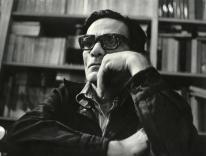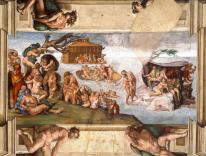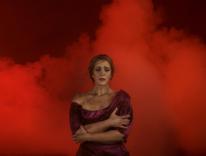Giacometti, on view at the Solomon R. Guggenheim Museum in New York City, June 8 through September 12, 2018
Writing on the occasion of Alberto Giacometti’s death in 1966, critic John Berger remarked that if the Swiss-born sculptor had lived in an earlier period, he would have been a religious artist. Indeed Giacometti, best known for his tall, skinny bronze renderings of human figures and now the subject of a major retrospective at the Guggenheim Museum in New York, shares with the Renaissance a fascination with perspective and a passion for painting and sculpture as tools for understanding the world. Berger’s observation also implies something about the artist’s temperament. Though a non-believer, Giacometti confronted the existential dilemmas of the 20th century—the loss of meaning caused by fading religious certainties, the devastation of two world wars, the social alienation generated by rising consumerism—with the quiet stability and determination of a monk. He didn’t chant the psalms, but Giacometti, now dark and brooding, now exuberant with praise, approached art (and life) with the same fervor and tenacity as the psalmist.
Comprised of nearly two hundred sculptures, paintings, and drawings, Giacometti aims to introduce a new generation of museum-goers to the modernist master’s life and work. Beginning by tracing Giacometti’s early aesthetic influences (the ancient totems of Africa, Oceania, and the Cyclades, but also the avant-garde cubism and surrealism of Picasso and Brancusi), the exhibit then unfolds in loose chronological order, with works rhythmically arranged in thematic clusters. As they flow by we experience three intertwined moments of Giacometti’s artistic development: the playful anxiety of his surrealist phase in the 1920s and ’30s, the kinetic frenzy of the postwar years (when he was excited by cities, motion, and existentialism), and the tender serenity of the late 1950s and early ’60s, when he trained his attention on the mystery of the human face.
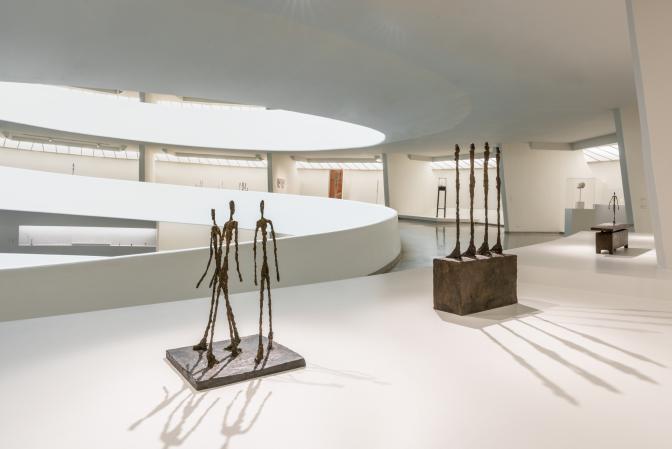
The show also represents a kind of homecoming for Giacometti. The Guggenheim hosted his first-ever museum show in 1955 (in a temporary location in a Manhattan apartment) as well as a posthumous retrospective in the iconic Frank Lloyd Wright building in 1974. The museum’s spiraling rotunda still feels like a natural fit for Giacometti’s sculptures, its smooth white curves highlighting their distinctive jaggedness as the play of light throws their elongated shadows into relief. The circular layout also invites visitors to view Giacometti’s art just as he did, repeatedly returning to the same pieces from changing perspectives. Archival materials (like sketches, writings, even old art history textbooks covered with hand-drawn copies) give a hint of the dynamism of Giacometti’s creative process, enabling us to engage with this notoriously hermetic artist on intimate terms. Winding up the ramps, we share the fears and frustrations, but also the discoveries and breakthroughs that nourished his lifelong “war,” as he called it, “to bite into reality…to see better, to understand better…to become more free.”
If freedom was Giacometti’s end goal, it certainly wasn’t his point of departure. From an early age he was plagued by paralyzing neuroses, facing recurring doubts about his artistic talent and self-worth, violent fears of death, and myriad sexual frustrations. After moving to a tiny studio in Paris in 1926, visual art (and in particular sculpture) became a way of coming to terms with his heavy, nearly impenetrable solitude, as he found in surrealism a symbolic language for grasping and expressing the hidden depths of his psyche.
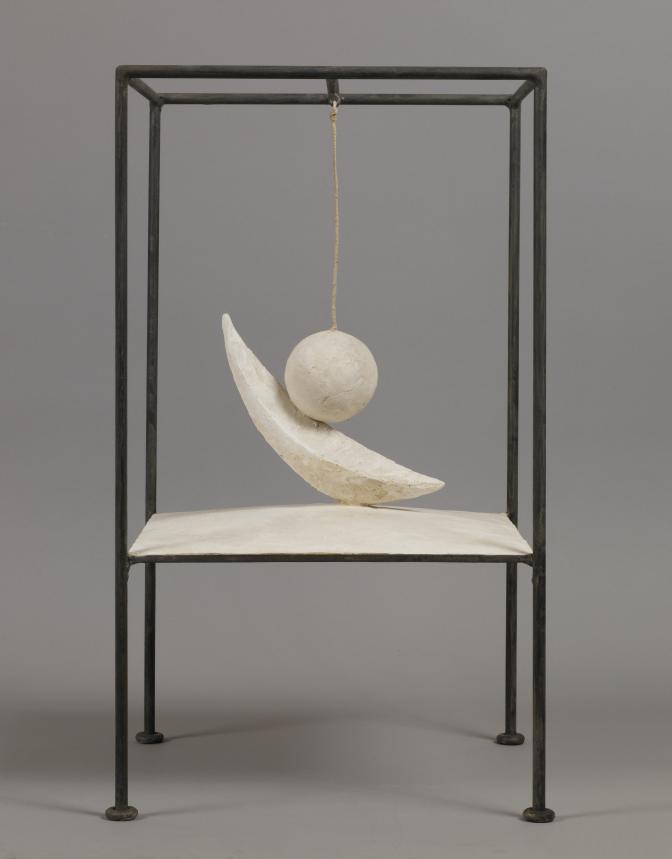
The most fascinating early works show Giacometti grappling with his hangups in a range of starkly vacillating moods. Playful compositions like the comically sexualized Suspended Ball (1931), in which a white sphere dangles just above a caged crescent, their surfaces mere millimeters apart, give way to forlorn monoliths like The Cube (1934), a twelve-sided polyhedron (taken from Albrecht Dürer’s Melencolia engraving) whose smooth surface is hastily scratched with a gloomy face. Other works return repeatedly to the theme of mortality, now with morbid humor (as in No More Play [1931], an imaginary board game featuring two figures standing in a horizontal plane, separated by a pair of empty graves), now with shocking violence (like in Woman with Her Throat Cut [1932], a writhing, spiked figure intended to be placed directly on the floor, ensnaring viewers like a booby trap). Giacometti even sculpts the ugly detritus of his soul, producing a pair of “disagreeable objects” intended to arouse nothing but revulsion—one of their titles actually includes instructions, “to be thrown out.”
And yet Giacometti’s surrealism, myopically limited to the private world of the inner self, could carry him only so far. His creativity collapsed in the mid-1930s, ushering in a period of scant productivity that lasted until 1946, when a transformative, visionary experience in a Paris movie theater suddenly enabled him to “see reality for the first time.” Fascinated by the forms of the world around him and steeped in the existentialist philosophy of his friends Jean-Paul Sartre and Simone de Beauvoir (a small bust of whom is displayed in the exhibit), Giacometti became confident that he could now “make everything very rapidly.” Working feverishly in the same Paris studio he had first occupied in 1926, he began a series of revolutionary sculptures—thin, enigmatic figures whose craggy bodies and flickering faces contain all the vitality of moving images.
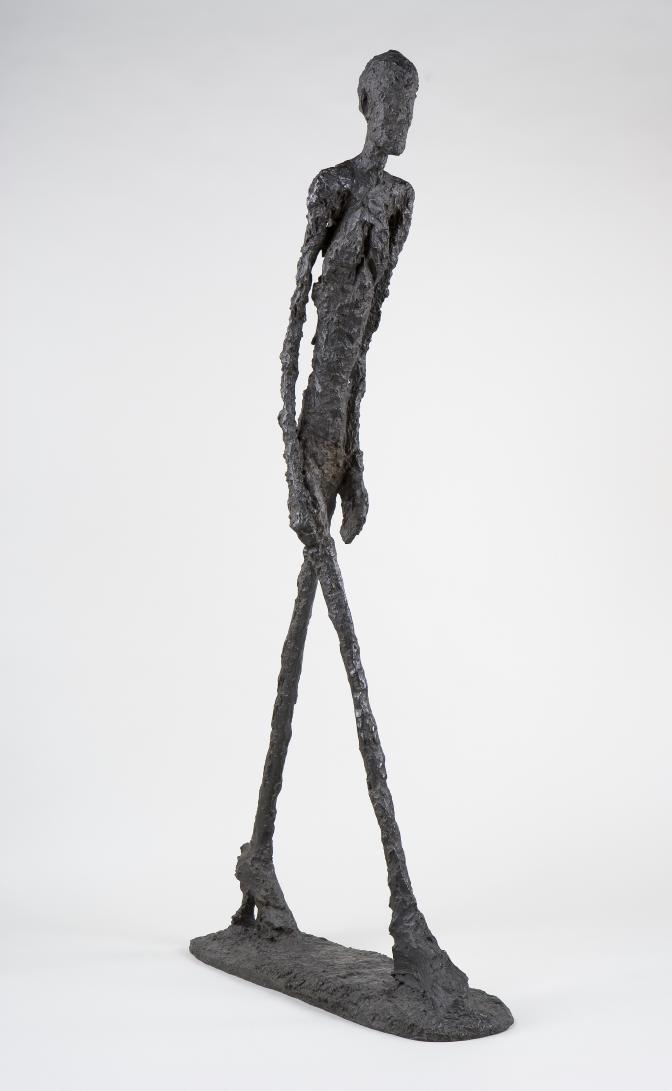
It’s at this point that the exhibit suddenly cracks open and gains momentum, conveying the same sense of forward motion that Giacometti observed in the crowded streets and plazas of postwar Paris. Though they vary in scale and quantity, almost all the sculptures displayed here depict people walking. Some, like City Square (1948), show multiple figures striding across a wide pedestal en plein air, while others, such as Figurine Between Two Houses (1950), feature solitary individuals in narrow, enclosed spaces. Uncannily, each figure moves with a unique gait: the slow, tentative steps of Three Men Walking (1948) contrast with the quick, decisive march of Walking Quickly Under the Rain (1948). Hastily sculpted and roughly cast (most lack precise facial features), these works draw our attention not so much to the beauty of the human figure itself (as in classical sculpture, which Giacometti studied extensively) as to the subtle grace conveyed by the form of human beings in motion. Contemplate the bronzes slowly, and then observe other visitors around you: like Giacometti, you’ll start to notice the mysterious singularity with which each person moves through the world.
Movement, as one essay in the exhibition’s catalogue notes, implies purpose—and no work more effectively conveys Giacometti’s quickening determination to “attack, to capture, to make as much progress as possible on every front” than his monumental Man Pointing (1947). Nearly six feet tall, the sculpture consists of a wiry male figure posing delicately on a pedestal. Gazing over his shoulder, he leans back gently and twists at the torso, with one arm curving up behind his head as the other tapers into a long, pointed index finger. The confidence of such a stance, in juxtaposition to the figure’s emaciated body, has led critics to interpret the sculpture as an optimistic symbol of Europe’s post-war recovery. That’s certainly true. But it’s also a hope-filled self-portrait, in which Giacometti, transcending his past, now gestures decisively toward the future.
The last fifteen years of Giacometti’s life were driven by a single all-consuming passion. Like Christian philosophers in the Middle Ages, he intuited that the very source, the animating principle of a person’s entire being, could be detected in the spark that flashes forth from their eyes. Right up until his death, Giacometti worked for hours each day in his cramped studio, dedicating himself to discovering the “truth” of the people seated before him. Using just a few live models (mostly his wife Annette and his brother Diego, but also the Japanese philosopher Isaku Yanaihara, as well as a favorite prostitute, named Caroline), Giacometti produced an almost never-ending series of busts and portraits that, like a curve approaching infinity, came nearer and nearer to approximating the fathomless mystery of their faces.
As you approach the final section of the exhibit on the Guggenheim’s upper ramps, more and more faces—some painted, others sculpted—begin to accumulate. One sculpture, Head of a Man (1953), strikes with particular force. Cast in white plaster and not particularly handsome, his scratched, weathered features (in particular his wide eyes, aquiline nose, and thin lips) nevertheless radiate a peaceful, engrossing stillness. But unlike the smooth, polished marble of a classical bust, which both idealizes and immortalizes its subject, the austere lines and coarse surfaces of Head of a Man feel provisional and incomplete. They track the precise points where Giacometti, sculpting from life, manipulated the plaster with his fingers, trying to remain as faithful as possible to the true likeness of the human being in front of him. The sculpture records a moment of failure, but also one of genuine intimacy, as if in shaping the plaster Giacometti were actually caressing the man’s face. It thus functions more like an icon, making the absent man—and Giacometti himself—eerily, even prayerfully, present.
Giacometti famously (and apophatically) believed that no one person can ever be fully known. In the end, we all remain a mystery to each other. But that’s hardly a bad thing. As I was leaving the Guggenheim, I found myself peering into the faces of other visitors, newly aware of the singular beauty of each. I might have felt guilty, or embarrassed, had I not realized that they were staring back at me.
Please email comments to [email protected] and join the conversation on our Facebook page.
Share
Previous Story
Beauty Behind Bars
Next Story
Social Justice Warrior
